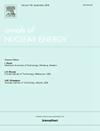Semi-empirical model for resuspension of multilayer sedimentary aerosols in pipes
IF 1.9
3区 工程技术
Q1 NUCLEAR SCIENCE & TECHNOLOGY
引用次数: 0
Abstract
As a critical phenomenon influencing radioactive release assessment during nuclear severe accidents, aerosol resuspension requires in-depth investigation, as it can affect the accuracy of radioactive release source term assessment. An experimental apparatus has been established and the resuspension of multi-layered sedimentary aerosols have been conducted under turbulent airflow conditions with Reynolds number ranging from 50,000 to 130,000. The experiments indicate that higher friction velocity of turbulent pipe and larger deposited particle size both increase the resuspension rate. Through mechanical fulcrum model analysis, the resuspension characteristics, which encompass the coupling effects of airflow characteristics, particle characteristics and wall characteristics, are revealed by the dimensionless particle diameter and critical dimensionless particle diameter . A semi-empirical aerosol resuspension model satisfying the S-Logistic function relationship is obtained and validated with multiple sets of experimental data, and showing good agreement between the model predictions and the experimental results.
管道中多层沉积气溶胶再悬浮的半经验模型
气溶胶重悬浮是影响核严重事故中放射性释放评估的关键现象,它会影响放射性释放源项评估的准确性,需要深入研究。建立了实验装置,在5万~ 13万雷诺数的紊流条件下对多层沉积气溶胶进行了再悬浮实验。实验表明,湍流管摩擦速度越大,沉积颗粒粒径越大,重悬浮速率越快。通过力学支点模型分析,通过无量纲颗粒直径dp+和临界无量纲颗粒直径dp50+揭示了气流特性、颗粒特性和壁面特性耦合作用下的再悬浮特性。建立了满足S-Logistic函数关系的半经验气溶胶再悬浮模型,并用多组实验数据进行了验证,模型预测结果与实验结果吻合较好。
本文章由计算机程序翻译,如有差异,请以英文原文为准。
求助全文
约1分钟内获得全文
求助全文
来源期刊

Annals of Nuclear Energy
工程技术-核科学技术
CiteScore
4.30
自引率
21.10%
发文量
632
审稿时长
7.3 months
期刊介绍:
Annals of Nuclear Energy provides an international medium for the communication of original research, ideas and developments in all areas of the field of nuclear energy science and technology. Its scope embraces nuclear fuel reserves, fuel cycles and cost, materials, processing, system and component technology (fission only), design and optimization, direct conversion of nuclear energy sources, environmental control, reactor physics, heat transfer and fluid dynamics, structural analysis, fuel management, future developments, nuclear fuel and safety, nuclear aerosol, neutron physics, computer technology (both software and hardware), risk assessment, radioactive waste disposal and reactor thermal hydraulics. Papers submitted to Annals need to demonstrate a clear link to nuclear power generation/nuclear engineering. Papers which deal with pure nuclear physics, pure health physics, imaging, or attenuation and shielding properties of concretes and various geological materials are not within the scope of the journal. Also, papers that deal with policy or economics are not within the scope of the journal.
 求助内容:
求助内容: 应助结果提醒方式:
应助结果提醒方式:


